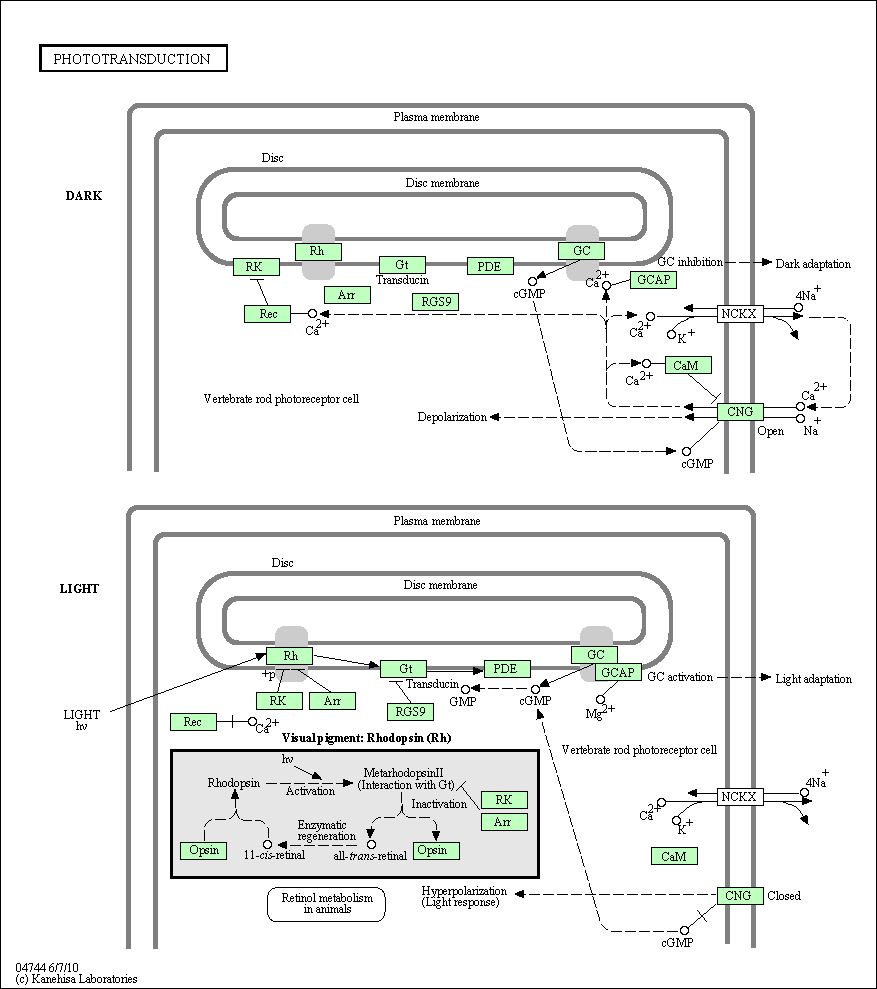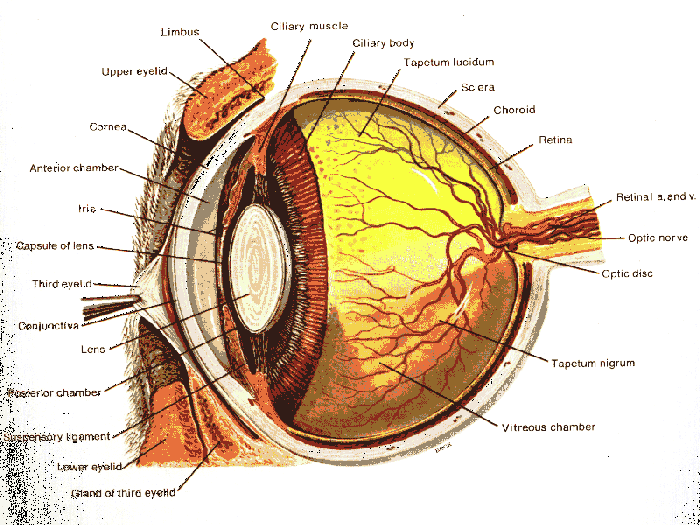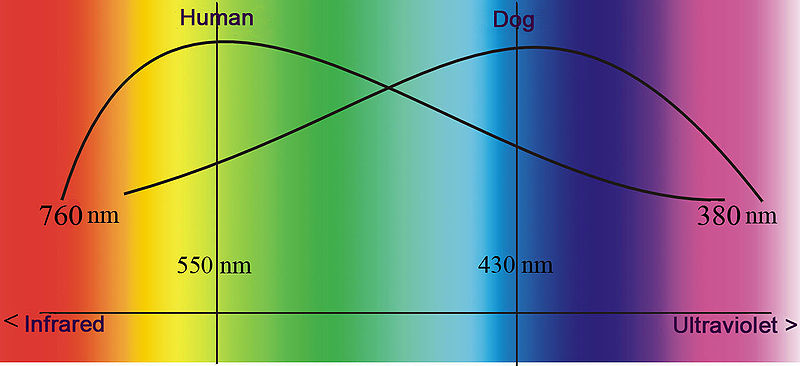Dogs
From Comparative Physiology of Vision
Contents |
| Dog | |
|---|---|
 |
|
| Scientific classification | |
| Kingdom: | Animalia |
| Phylum: | Chordata |
| Class: | Mammalia |
| Order: | Carnivora |
| Family: | Canidae |
| Genus: | Canis |
| Species: | C. lupus |
| Subspecies: | C. l. familiaris |
General Anatomy
- Dogs generally have the same anatomical structure as humans[2]
- Dogs have a third eyelid, called the nictitating membrane, which further protects the eye, spreads tearfilm over the cornea, and is involved in tear production.[2]
- Dogs have a tapetum lucidum behind the retina, which is highly reflective, and increases night vision.[2]
- Dogs have no fovea. The central area of the retina, called the visual streak, is 20% cones (compared to the human 100% cones that make up the fovea).[3]
Unique Visual Optics
- Anatomically, the dog and human eye are similar. Dogs, however, have historically been more active at night. Large pupils; larger, thicker lenses, and large corneas all give the dog increased light gathering and refracting capabilities which help them see in dim light. These characteristics also make the dog near sighted [3].
- Dog visual acuity is also effected by the ratio of rods to cones in the retina. The dog retina has a much higher ratio of rods to cones. The receptive fields for ganglion cells which innervate cones are smaller than that of rods. Therefore, cones are responsible for the ability to distinguish detail. Since the dog has only 20% cones in the central area of the retina, it makes sense that they would have lower visual acuity [3].
Photo Transduction
see the House Mouse - Photo Transduction section of the Domestic Animals Sensory Physiology wiki for detailed explanation of photo transduction [[1]]
Here is another dog photo transduction schematic [4]
Color Vision
Dogs are dichromats. The photo pigments in their cones respond maximally to light wavelengths of 429 nm to 555 nm. This dichromacy is similar to red/green colorblindness in humans. At 480 nm, the wavelength that appears greenish blue to humans, dogs have a neutral point, where everything appears white. Any wavelength longer than the neutral point is indistinguishable yellow.[3]
Motion Detection
- Dogs and Cats have better motion detection than humans in low light and when the object is in the periphery.[5]
- Dogs can detect a moving object 810-900 meters away. If the same object is still, they can only detect it at 585 meters or less.[5]
- Dogs have flicker fusion rates ( rate at which a flickering image appears constantly illuminated) of 70-80 hz. Television images are only updated 60 times per second, so they appear as rapidly flickering images to a dog instead of a fluid story line.[5]
- The average visual field for dogs is 240 degrees. For humans it is 180 degrees. However, the extent of canine visual fields varies greatly due to length of snout and separation of eyes.[5]
Neuronal Processing
Higher Order Visual Perception
Evolutionary Significance
- Evolutionarily speaking, lower visual acuity and dichromacy are not a disadvantage. The dog’s eye evolved to aid it in hunting at night, which is aided by the ability to detect lower levels of light. Also, the trade off for poor visual acuity is higher sensitivity. While dogs may not be able to distinguish as much detail as humans, they are able to detect movement much better. [5]
Sources
- ↑ Seminar, The Dog: Management. Retrieved from: http://netvet.wustl.edu/species/dogs/caninmgt.txt
- ↑ 2.0 2.1 2.2 2.3 Zigler Veterinary Professional Cooperation (2006). Anatomy of Canine Eye. Retrieved from: http://www.eyevet.ca/anatomy.html
- ↑ 3.0 3.1 3.2 3.3 Davis, Jennifer (1998). Dr. P’s Dog Training: Color and Acuity Differences between Dogs and Humans. Retrieved from: http://www4.uwsp.edu/psych/dog/LA/davis2.htm
- ↑ Kanehisa Laboratories (2010, June 7). Phototransduction - Canis familiaris (dog). Retrieved from: http://www.kegg.jp/kegg-bin/show_pathway?cfa04744l
- ↑ 5.0 5.1 5.2 5.3 5.4 Miller, Paul E. DVM (2006). Vision in Animals-What do Dogs and Cats See? Retrieved From: http://www.malamutehealth.org/articles/eye_vision.htm


